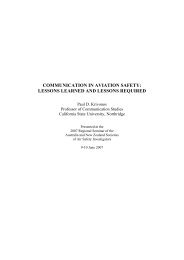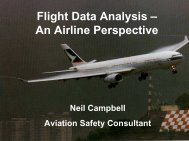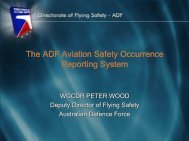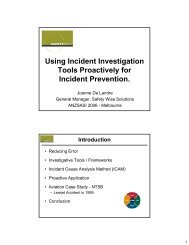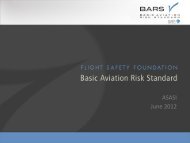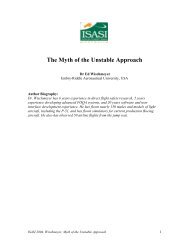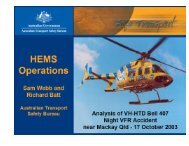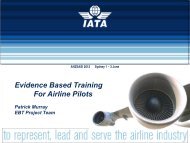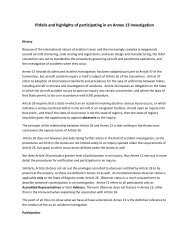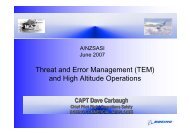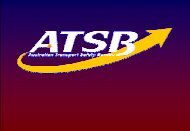ADF AVIATION SAFETY OCCURRENCES: LESSONS ... - ASASI
ADF AVIATION SAFETY OCCURRENCES: LESSONS ... - ASASI
ADF AVIATION SAFETY OCCURRENCES: LESSONS ... - ASASI
Create successful ePaper yourself
Turn your PDF publications into a flip-book with our unique Google optimized e-Paper software.
<strong>ADF</strong> <strong>AVIATION</strong> <strong>SAFETY</strong><strong>OCCURRENCES</strong>: <strong>LESSONS</strong>LEARNTWGCDR PETER WOOD DDFS 1 JUN 03
✈ Preservation ofcombat power✈ Effective riskmanagement policy✈ Requires proactiveand reactivemeasures<strong>ADF</strong> <strong>AVIATION</strong> <strong>SAFETY</strong> PHILOSOPHY
DFS-<strong>ADF</strong> CAPABILITIESPROACTIVE✈ Support to Commanders✈ Policy / Procedures Development✈ Safety Education and Awareness✈ Safety Health Reviews✈ ResearchREACTIVE✈ Accident Investigation✈ Incident Investigation / Statistical Analysis
DFS PRO-ACTIVE ACTIVITIES
<strong>ADF</strong> RE-ACTIVE ACTIVITIESACCIDENT AND INCIDENTINVESTIGATION
AIRCRAFTACCIDENTINVESTIGATIONS
<strong>ADF</strong> AIRCRAFT DESTROYED - 2292018161412ADD:74 - 1 x Iroquois, Cyclone TRACEY76 - 9 x Tracker, Nowra hangar fire79 - 1 x Skyhawk, rolled off deck97 - 1 x Leased Twin Otter, CFIT01 - 1 x Squirrel (Provisional)108642065 70 75 80 85 90 95 00
18<strong>ADF</strong> ACCIDENT STATISTICS1990 +161412108642FATALITIESAIRCRAFT DESTROYED01990 1995 2000
<strong>ADF</strong> ACCIDENTS PER 10K HOURSVS PREVIOUS 5YR AVERAGE<strong>ADF</strong> Accidents per 10K Hours vs Previous 5yr Average0.350.300.33Per 10K Hrs0.250.200.150.100.240.250.160.240.230.240.20 0.190.160.19Acc. Per 10K HrsPrevious 5Yr AverageLinear (Acc. Per 10K Hrs)Log. (Acc. Per 10K Hrs)0.050.080.0096/97 97/98 98/99 99/00 00/01 01/02FY
THE FACT THAT YOU ARE NOTHAVING ACCIDENTS DOES NOT BYITSELF MEAN YOUR SYSTEM IS SAFE….
<strong>ADF</strong> <strong>AVIATION</strong> <strong>SAFETY</strong><strong>OCCURRENCES</strong>
INCIDENTS PER 10K HOURSIncidents per 10K Hrs250200150126.7141.3168.3153.9197.1188.710050096/97 97/98 98/99 99/00 00/01 01/02
PERCENTAGE OF HUMAN &MATERIEL INCIDENTS - <strong>ADF</strong> WIDEPercentage of Human and Materiel Incidents - <strong>ADF</strong> Wide60.0%50.0%40.0%30.0%20.0%48.5%43.3%47.8% 47.2%45.3% 44.5%47.2% 48.0% 48.1%42.7%38.9% 38.4%HumanMateriel10.0%0.0%96/97 97/98 98/99 99/00 00/01 01/02
REVIEW OF 2002 <strong>ADF</strong><strong>OCCURRENCES</strong>✈ 2407 total (<strong>ADF</strong>) ASORs IN CY02✈2275 in CY01✈ 1174 Human ‘Causes’✈1148 in CY01✈ @525 MASORs✈ 149 Birdstrikes✈ Zero Fatal Accidents✈ 1 aircraft destroyed
DFS-<strong>ADF</strong> INVESTIGATIONS2000 3 Accidents/7 Incidents investigated by DFS2001 7 Accidents/2 Incidents/ 1 Review2002 EVENTTEAM!20 Feb 02 RNZN Seasprite FOCFT Assisting NZHQ!20 Mar 02 Kiowa Heavy Landing AIIT!6 Jun 02 Kiowa Taxiing Accident AAIT!26 Jun 02 F-111C Darwin AAIT!20 Oct 02 SK50 Hobart AIIT for MCAUST!28 Oct 02 Kiowa Heavy Landing AAIT
2002 EVENTOTHER INVESTIGATIONSTEAM!16 Feb 02 Tiger Moth Williamtown Support to ATSB!26 Sep 02 Cherokee Hamilton Island Support to ATSB!13 Oct 02 Cessna 182 Bungendore Support to ATSB
<strong>ADF</strong> INVESTIGATIONS 2003DATE EVENT TEAM!17 Jan 03 USN FA-18C Runway Overrun WA Joint 85/2A!23 Jan 03 Kiowa Heavy Landing DFS AAIT!31 Jan 03 Ilyushin IL-76TD Timor-Leste Joint ATSB/DFS!8 Feb 03 Caribou Runway Departure PNG DFS AAIT!19 Feb 03 Qantas B737 Incident Darwin Joint ATSB/DFS!23 Feb 03 BBJ Ground Incident Fairbairn DFS AIIT!26 Mar 03 Seahawk AFCS Coupler failure FEG-based AAIT!31 Mar 03 MBZ Incident Pearce FEG-based AAIT!7 May 03 CH47 Unplanned Load release FEG-based AIIT
31 JAN 03 ILYUSHIN IL-76TD TIMOR-LESTEJOINT ATSB/DFS-<strong>ADF</strong> TEAM
F111C A8-112 DARWIN 26 JUN 02 F2FUEL TANK EXPLOSION
F111C A8-112 DARWIN✈ Aircraft landed safely, crew uninjured, aircraft repairable✈ Over pressurisation of the F-2 fuel tank is the most plausiblecause.✈ Most likely ignition source is the wiring loom between BoostPump #3 and the aft wall of the F2 fuel tank.✈ Explosive build up of pressure due to the ignition of fuelvapours.✈ Investigation complete✈ Most recommendations accepted and being actioned✈ Report was as detailed and as complex as any recent DFSinvestigation✈ Recommendations far-reaching for <strong>ADF</strong> technicalairworthiness regime
5101520254.4 Performance during the peak of a stormThe results presented up to now represent average statistic parameters, obtained froma relative long period of data, and so they reflect the general behaviour of the modelsand the BMA for all meteorological conditions. However, the objective of a good sealevel forecast should be an adequate simulation of the peak of a storm. Figure 12shows the forecasts for the largest storm of the period of study, at Bilbao station. Aswe pretend to check the improvement of the BMA, for the sake of simplicity we showjust the output from nivmar and eseoat sources, as well as the output of the threedifferent BMA’s with different training periods.It can be seen that the peak of the storm is better reproduced by nivmar source, andthat in this case, the BMA’s available do not improve the forecast, although they dobetter than eseoat in any case. This is an important result that should be explored indetail. We also see at this particular harbour that the BMA which gets closer to the peakis bma ibi1, with 15 days of training period, although this can be different at anotherharbour. In fact, if we have a look to the statistical parameters for the whole period forBilbao, we see that these are better for a training period of 4 days (bma ibi2). This iscontradictory with what it is expected and with results for the North Sea (Beckers et al.,2008), where peaks were reproduced better with shorter training periods.It is also remarkable the reasonably good forecast of nivmar of the peak of the storm.One possible explanation for this is the adequate representation of the continental platform,very narrow here, for the nivmar system: it was manually and carefully correctedbefore final implementation. This is something that was not done in the rest of thesources, not so focused on sea level, such as eseoat.It seems, in any case, that a better determination of the BMA weights and parametersmay be needed for an adequate forecast of extreme events. Beckers et al. (2008)suggest already this idea and propose to determine these weights based on the performanceof the models during extreme meteorological conditions instead of during arecent training period.782Discussion Paper | Discussion Paper | Discussion Paper | Discussion Paper |OSD8, 761–800, 2011ENSURF: multi-modelsea level forecastB. Pérez et al.AbstractConclusionsTables◭◭BackTitle PageIntroductionReferencesFigures◮◮CloseFull Screen / EscPrinter-friendly VersionInteractive Discussion
28 OCT 02 KIOWA HEAVYLANDING✈ QFI was conducting power terminated autorotationaltraining.✈ Aircraft terminated high (25-30 ft) when rotor rpmstarted to decay.✈ As aircraft approached ground, QFI could not arrestROD and landing gear failed.✈ One of three Kiowa autorotation incidents in pastyear: in all accidents crew were uninjured and aircraftrepairable✈ Similar incidents with similar factors andrecommendations✈ CULTURE!!
23 JAN 03 KIOWA HEAVY LANDING✈ Staff development autorotational training.✈ Co-pilot conducting low level autorotation had a stinger (tailstrike).✈ Aircraft nosed over when captain took over and pulled back oncyclic.✈ Aircraft settled level on ground but not before main rotor strucktail rotor drive shaft.
CARIBOU ACCIDENTYALUMET PNG 8 FEB 03✈ On 8 Feb 03, a 38 SQN Caribou departed the Yalumetrunway in PNG on an asymmetric landing.✈ No reported injuries, aircraft repairable.✈ DFS-<strong>ADF</strong> Aircraft Accident Investigation Team formed.
✈DFS mainly investigates(since 99) accidents wherethe crew survived and theaircraft is repairable✈Same investigativetraining, procedures,equipment, techniques usedas for major accidents withfatalities✈Just as manyorganisational lessons canbe learnt and deficienciesidentified
WHAT ABOUT ‘SIMPLER’INCIDENTS?
UNIT INVESTIGATIONS✈ Many of the CY2002 <strong>ADF</strong> ASORs detail occurrenceswith organisational deficiencies✈ The only difference between an accident and a ‘whew,that was lucky’ is the consequence✈ For example:
<strong>ADF</strong> ASOR EXAMPLES✈ VIKING WERE CONDUCTING 4 SHIP LOW LEVEL ATTACKS. VIKING 1 AND 2WERE CONDUCTING THE FIRST 25/10 POP FROM A 10 NM INGRESS. VIKING 2WAS BRIEFED TO BE 30 DEGREES SWEPT AT 1 MILE FROM VIKING 1. VIKING 2ACCELERATED TO 540 KNOTS INSIDE 10 MILES WHILST CONDUCTING COCKPITCHECKS. VIKING 1 ACCELERATED LATER DUE TO THE OVERFLIGHT OF SOMEFARM BUILDINGS, RESULTING IN A PURE SPREAD FORMATION BETWEENVIKING 1 AND 2 AT THE OFFSET POINT OF 5 MILES. VIKING 1 AND 2 NOTICEDTHE FORMATION DISPOSITION AT THE OFFSET BUT CONTINUED WITH THEPASS. VIKING 2 APEXED JUST UNDER AN OVERCAST LAYER AND CONTINUEDTHE PASS, LOSING VISUAL WITH VIKING 1 WHILE FOCUSING ATTENTION ONTHE WEATHER AND PASS PARAMETERS. VIKING 2 CONTINUED FOR WEPONSRELEASE (SIMULATED). AS VIKING 1 WAS IN THE DIVE HE NOTICED THATVIKING 2 WAS ON A CONVERGING FLIGHTPATH APPROXIMATELY 200 FEETBELOW AND DISPLACED ONE TO 2 ECHELON WIDTHS ABEAM . VIKING 1PULLED UP AS VIKING 2 PASSED UNDERNEATH AND COMMENCED A LATERALBREAKAWAY TOWARDS THE POSITION JUST VACATED BY VIKING 1.
WHAT IF THEY HAD HIT?✈ DFS Investigation✈ BOI ReportSo, why not…...✈ Carry out an investigation and take corrective actionsas if they had collided?✈ Detailed ASOR report disseminated to <strong>ADF</strong> aviationcommunity in Feedback✈ Issues included Operations tempo, currency, flightprogramming, standard profiles, training, airspaceavailability, briefings and SIs
✈ AT APPROX 100 FT THE AIRCRAFT CAPTAIN DIRECTED THE RHS FLYING PILOTTO COME SLIGHTLY LEFT TO REGAIN RUNWAY CENTERLINE. DURINGTHISCORRECTION A GUST FROM THE REAR RIGHT QUADRANT LIFTED THE RIGHTWING AND PUSHED THE AIRCRAFT THROUGH CENTERLINE. FULL RIGHTAILERON REQUIRED BOTH HANDS ON THE YOKE AND RUDDER WAS APPLIED. ATTHIS STAGE THE AIRCRAFT BEGAN TO SINK RAPIDLY. THE RHS PILOTCOMMENCED APPLYING POWER BUT THE AIRCRAFT CONTINUED TO SINK ANDDEPART LEFT. THE AIRCRAFT CAPTAIN DIRECTED A GO AROUND WHENAIRCRAFT WAS STABLE, PARALLEL TO AND ONE WINGSPAN LEFT OF THERUNWAY AND APPROACHING THE LAST POINT OF SAFE TOUCH DOWN. THE LHSQFI THEN ASSISTED WITH THE THROTTLES AND APPLIED ADDITIONAL POWERAND A GO AROUND FROM BETWEEN 10 AND 20 FT WAS COMMENCED.
✈ THE RHS PILOT ASSUMED THAT THE QFI HAD TAKEN OVER ANDRELEASED THE YOKE WITH THE AIRCRAFT CLIMBING AWAY. THELHS QFI THE CALLED "YOUR YOKE MY THROTTLES ". THE RHS PILOTTHEN TOOK DIRECTIONAL CONTROL REQUIRING BOTH HANDS TOHOLD FULL RIGHT AILERON IN THROUGHOUT THE GO-AROUND. THELHS QFI APPLIED AND MAINTAINED TAKE OFF POWER ANDCOMMENCED RETRACTING THE GEAR AND FLAP. THE AIRCRAFTWAS TRACKED VIA THE LOWEST DEPARTURE GRADIENT ANDCLEARED THE SURROUNDING TREES BY BETWEEN 20 AND 100 FTWITH A NORMAL CLIMB GRADIENT. NO AIRCRAFT LIMITS WEREEXCEEDED IN THE GO AROUND. THE AIRCRAFT WAS CLEANED UPAND THE INCIDENT DEBRIEFED INCLUDING HANDOVER TAKEOVERDRILLS.
WHAT IF THEY HIT THETREES?✈ DFS Investigation✈ BOI ReportSo, why not…...✈ Carry out an investigation and take corrective actionsas if they had impacted the ground?✈ Detailed ASOR report disseminated to <strong>ADF</strong> aviationcommunity in Feedback✈ Issues included self-authorisation, ergonomics,supervision, HO/TO procedures, one-way stripoperations, committal points.
✈Investigatethe incident toprevent theaccident
UNIT-LEVEL INCIDENTINVESTIGATION✈ Can be just as powerful safety tool as full accidentinvestigation✈ Unit commanders must support✈ Unit investigators require training and equipment✈ Units must be resourced✈ Time must be available✈ Investigation actions and recommendations must beactioned in a timely fashion: ie, system must beclosed loop
SO WHAT ARE WE (THE <strong>ADF</strong>) DOING?
✈ Improved ASORSystem✈ ASOR ReviewBoards✈ Training for UnitAviation SafetyOfficers✈ Safety ProgramGuides forCommanders
FEATURES OF THE NEWSYSTEM✈ Defence Aviation Hazard Reporting and TrackingSystem (DAHRTS)✈ Closed Loop Hazard/ASOR Review and Tracking System✈ One occurrence investigation methodology✈Guides for UASOs, Investigation Officers✈Based on the Reason Model and current ‘best practise’✈Easy to use once trained✈ One ‘contributing factor’ taxonomy✈Investigation must be completed first✈Descriptors at all levels✈Simple database entry
FEATURES OF THE NEW SYSTEM✈ Four Distinct classes of aviation safety occurrence(ICAO-compatible)✈Accident (DFS)✈Serious Incident (DFS/Group/Wing)✈Incident (Unit/Detachment/Flight)✈Event (None!)✈ Intranet - based…..Oracle database.✈ Visibility to commanders of:✈ASOR/Hazard action/recommendation resolution✈ASOR/Hazard Closure✈ASOR/Hazard Trends and Statistics
THANK YOU!



